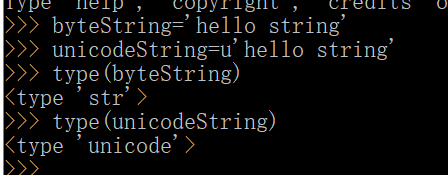第三讲:字符串类型判断与转换
字符串类型判断与转换
一、字节字符串和unicode字符串
1、basestring
在python中字符串的相关数据类型为str和unicode,他们都是basestring的子类,可见str和unicode是两种不同类型的字符串对象。
2、创建字符串
byteString='hello string'
unicodeString=u'hello string'
type()查看变量类型

二、判断是否是字符串(str和unicode):
1、用isinstance()函数判断:判断一个对象的变量类型,如果是返回True,不是返回False
# encoding=utf-8 byteString='hello normal string' unicodeString=u'hello unicode' if isinstance(byteString,basestring): print byteString, u'是字符串' if isinstance(unicodeString,basestring): print unicodeString,u'是字符串' 运行结果: hello string 是字符串 hello unicode 是字符串
2、判断是否是unicode:
# encoding=utf-8 byteString='hello normal string' unicodeString=u'hello unicode' if isinstance(byteString,unicode): print byteString, u'是unicode' if isinstance(unicodeString,unicode): print unicodeString,u'是unicode'
运行结果: hello unicode 是unicode
3、判断是否是str:
byteString='hello string' unicodeString=u'hello unicode' if isinstance(byteString,str): print byteString, u'是str' if isinstance(unicodeString,str): print unicodeString,u'是str'
运行结果: hello string 是str
三、不同字符串类型互转
1、不指定编码解码类型进行互转--使用系统默认编码:
s='hello string' print type(s) u=s.decode() #str 转 unicode print type(u) backToStr=u.encode() #unicode 转 str print type(backToStr)
运行结果: <type 'str'> <type 'unicode'> <type 'str'>
2、指定编码解码类型进行转换:
# encoding=utf-8 s='hello string' print type(s) u=s.decode('utf-8') #str 转 unicode print type(u) backToStr=u.encode('utf-8') #unicode 转 str print type(backToStr) 运行结果: <type 'str'> <type 'unicode'> <type 'str'>



 浙公网安备 33010602011771号
浙公网安备 33010602011771号